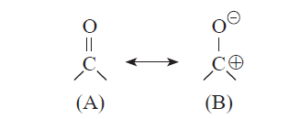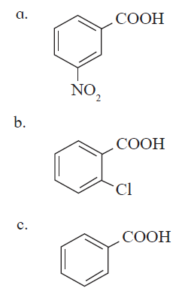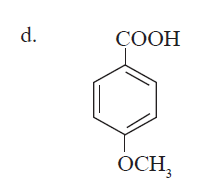12. ALDEHYDES, KETONES AND CARBOXYLIC ACIDS Textbook Solution Class 12 – Chemistry
1. Choose the most correct option.
i. In the following resonating structures A and B, the number of unshared electrons in valence shell present on oxygen respectively are

a. 2, 4 b. 2, 6
c. 4, 6 d. 6, 4
ii. In the Wolf -Kishner reduction, alkyl aryl ketones are reduced to alkyl benzenes. During this change, ketones are first converted into
a. acids
b. alcohols
c. hydrazones
d. alkenes
iii. Aldol condensation is
a. electrophilic substitution reaction
b. nucleophilic substitution reaction
c. elimination reaction
d. addition – elimination reaction
v. Diborane reduces
a. ester group b. nitro group
c. halo group d. acid group
vi. Benzaldehyde does NOT show positive test with
a. Schiff reagent
b. Tollens’ ragent
c. Sodium bisulphite solution
d. Fehling solution
2. Answer the following in one sentence
i. What are aromatic ketones?
ii. Is phenyl acetic acid an aromatic carboxylic acid ?
iii. Write reaction showing conversion of ethanenitrile into ethanol.
v. Name the product obtained by reacting toluene with carbon monoxide and hydrogen chloride in presence of anhydrous aluminium chloride.
vi. Write reaction showing conversion of Benzonitrile into benzoic acid.
vii. Name the product obtained by the oxidation of 1,2,3,4-tetrahydronaphthalene with acidified potassium permanganate .
viii.What is formalin ?
ix. Arrange the following compounds in the increasing order of their boiling points :
Formaldehyde, ethane, methyl alcohol.
x. Acetic acid is prepared from methyl magnesium bromide and dry ice in presence of dry ether. Name the compound which serves not only reagent but also as cooling agent in the reaction.
3. Answer in brief.
ii. Formic acid is stronger than acetic acid. Explain.
iii. What is the action of hydrazine on cyclopentanone in presence of —. KOH in ethylene glycol ?
iv. Write reaction showing conversion of Acetaldehyde into acetaldehyde dimethyl acetal.
v. Aldehydes are more reactive toward nucleophilic addition reactions than ketones. Explain.
vi. Write reaction showing the action of the following reagent on propanenitrile –
a. Dilute NaOH
b. Dilute HCl ?
vii. Arrange the following carboxylic acids with increasing order of their acidic strength and justify your answer.

4. Answer the following
i. Write a note on –
a. Cannizaro reaction
b. Stephen reaction
ii. What is the action of the following reagents on toluene ?
a. Alkaline KMnO4 , dil. HCl and heat
b. CrO2Cl2 in CS2
c. Acetyl chloride in presence of anhydrous AlCl3.
iv. Write reaction showing conversion of p- bromoisopropyl benzene into p-Isopropyl benzoic acid ( 3 steps).
v. Write reaction showing aldol condensation of cyclohexanone.



